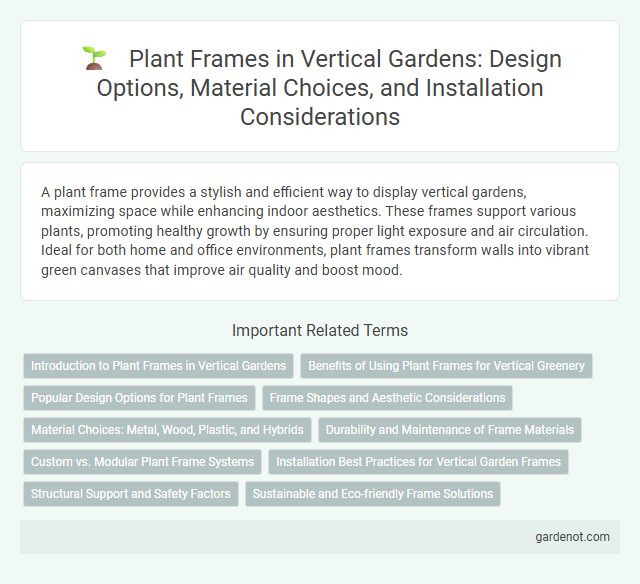A plant frame provides a stylish and efficient way to display vertical gardens, maximizing space while enhancing indoor aesthetics. These frames support various plants, promoting healthy growth by ensuring proper light exposure and air circulation. Ideal for both home and office environments, plant frames transform walls into vibrant green canvases that improve air quality and boost mood.
Introduction to Plant Frames in Vertical Gardens
Plant frames serve as the foundational structures that support vertical gardens, enabling plants to grow upward while maximizing limited space. These frames are typically made from materials such as metal, wood, or plastic, designed to hold planters, pots, or directly support climbing plants for efficient vertical growth. By facilitating optimal sunlight exposure and air circulation, plant frames enhance plant health and contribute to the aesthetic appeal of vertical garden installations.
Benefits of Using Plant Frames for Vertical Greenery
Plant frames for vertical greenery maximize space utilization by supporting a diverse array of plants in compact urban environments. They enhance air quality and insulation by increasing green surface area on walls, which helps regulate indoor temperatures and reduce energy costs. Structured plant frames also simplify maintenance and watering, promoting healthier plant growth and longer-lasting vertical gardens.
Popular Design Options for Plant Frames
Popular design options for plant frames in vertical gardens include modular panels, pocket planters, and freestanding structures. Modular panels allow flexible arrangement and easy expansion, while pocket planters provide individual compartments for diverse plant species, enhancing aesthetic appeal. Freestanding frames offer versatile placement and support larger plant varieties, making them ideal for both indoor and outdoor vertical gardens.
Frame Shapes and Aesthetic Considerations
Plant frames for vertical gardens come in various shapes such as rectangular, square, circular, and hexagonal, each offering unique structural support and visual appeal. The choice of frame shape significantly influences the overall aesthetics, creating patterns that can complement indoor or outdoor decor styles. Selecting frames with clean lines and harmonious proportions enhances the garden's artistic impact while ensuring optimal plant growth and maintenance.
Material Choices: Metal, Wood, Plastic, and Hybrids
Plant frames for vertical gardens come in diverse materials, including metal, wood, plastic, and hybrids, each offering unique benefits and durability. Metal frames provide strength and resistance to weather, making them ideal for outdoor installations, while wood frames contribute a natural aesthetic but require treatment to prevent rot and insect damage. Plastic and hybrid materials combine lightweight properties with moisture resistance, enhancing versatility and ease of maintenance for vertical garden structures.
Durability and Maintenance of Frame Materials
Vertical garden plant frames constructed from powder-coated steel or aluminum offer exceptional durability, resisting rust, corrosion, and harsh weather conditions. Frames made with high-quality, UV-resistant plastics provide low maintenance and longevity, minimizing the need for frequent replacements. Regular cleaning combined with sturdy material selection ensures the frame maintains structural integrity and supports healthy plant growth over time.
Custom vs. Modular Plant Frame Systems
Custom plant frame systems offer tailored dimensions and materials to fit unique vertical garden spaces, ensuring optimal plant growth and aesthetic appeal. Modular plant frame systems provide flexibility with interchangeable panels and standardized sizes, allowing easy expansion and maintenance. Both systems enhance vertical gardening, but choice depends on space constraints, design preferences, and budget considerations.
Installation Best Practices for Vertical Garden Frames
For optimal installation of vertical garden plant frames, ensure secure mounting on a sturdy, level surface using corrosion-resistant anchors suited for the wall material. Maintain proper spacing between frames to allow adequate air circulation and plant growth, while using waterproof backing to protect walls from moisture damage. Regularly check the frame's stability and alignment to support plant health and prevent structural issues.
Structural Support and Safety Factors
Plant frames in vertical gardens provide essential structural support by securely holding various plant containers while maintaining stability under weight and environmental stress. High-quality materials such as galvanized steel or reinforced aluminum enhance durability and prevent corrosion, ensuring long-term safety. Safety factors include load-bearing capacity calculations, wind resistance, and proper anchoring to prevent frame collapse and protect both plants and nearby structures.
Sustainable and Eco-friendly Frame Solutions
Plant frames designed for vertical gardens utilize sustainable materials such as reclaimed wood, recycled metals, and biodegradable composites to minimize environmental impact. These eco-friendly frame solutions support healthy plant growth while reducing carbon footprints and promoting green building practices. Incorporating modular and durable designs enhances resource efficiency and allows for easy maintenance and scalability in urban greening projects.
Plant frame Infographic

 gardenot.com
gardenot.com